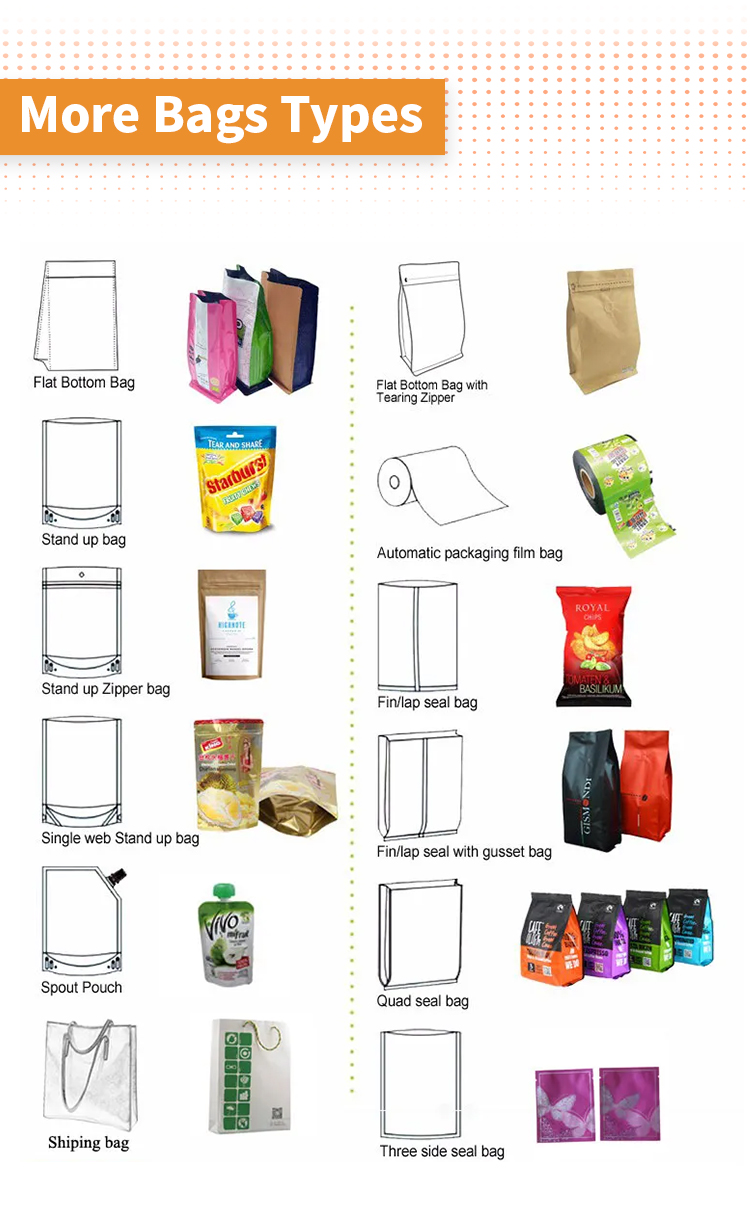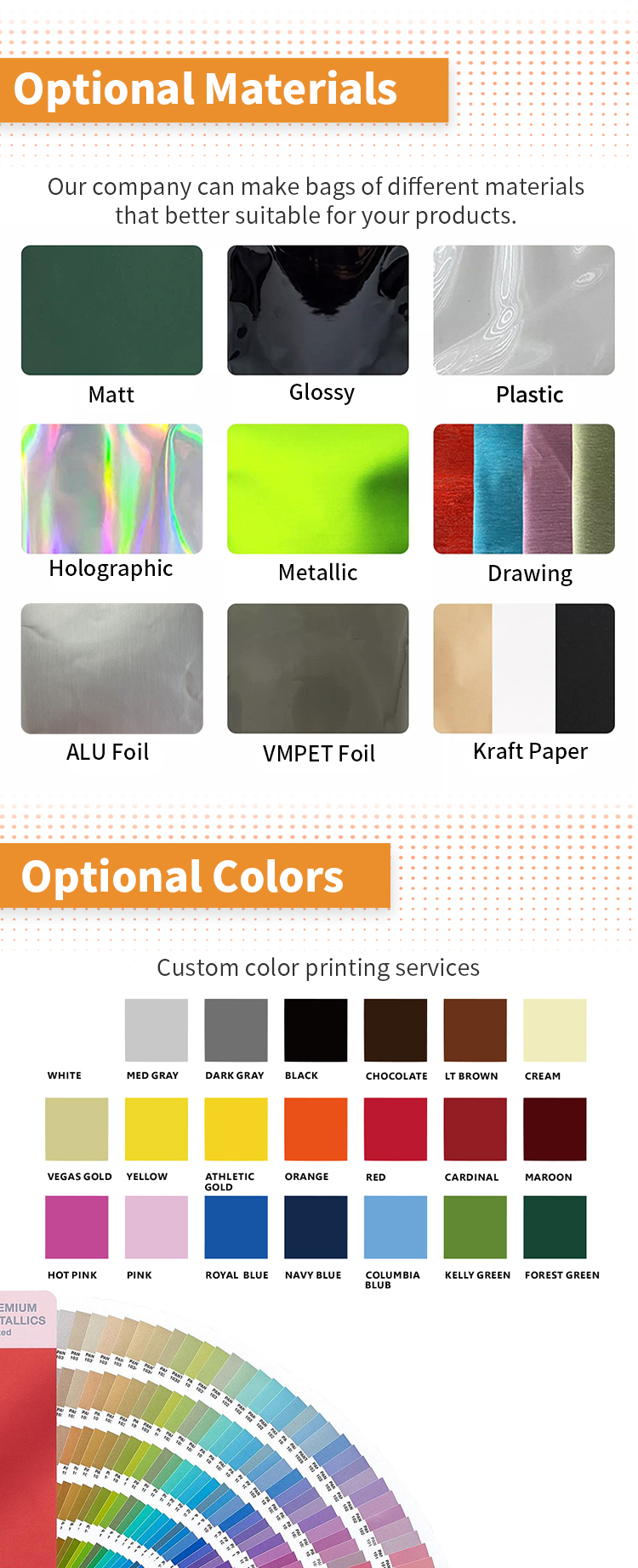- English
- Sales & Support:0086 755 89315501 / 18688718622
| Place of Origin: | China |
| Brand Name: | Die Cut Mylar Bags |
| Certification: | ISO、SGS |
| Model Number: | Special Shape Bags-CH009 |
| Minimum Order Quantity: | 200pieces |
|---|---|
| Price: | Price Based On Product Design |
| Packaging Details: | Carton Box |
| Delivery Time: | 7 to 12 days |
| Payment Terms: | Paypal、T/T、MoneyGram、D/P、D/A、W |
| Supply Ability: | 1200000pcs/Months |
Die cutting is a precise and versatile process used in the packaging industry to create intricate shapes and designs in various materials. It involves cutting, scoring, or perforating materials using a custom-made die—a tool with a specific pattern. Die cut packaging, such as die cut pouches, adds a touch of creativity, functionality, and uniqueness to products, setting them apart on the shelves. This topic delves into the details of die cutting and its significance in packaging.

| Die Cutting Technique | Description | Suitable Materials | Speed | Precision |
|---|---|---|---|---|
| Flatbed Die Cutting | Involves a flat die pressed onto the material, suitable for a wide range of materials and shapes. | Paper, Cardboard, Plastic | Medium to High | High |
| Rotary Die Cutting | Uses a rotating cylindrical die for high-speed production, often used for labels and continuous materials. | Paper, Labels, Foils | High | Medium to High |
| Laser Cutting | Utilizes laser beams to precisely cut materials, suitable for intricate and delicate designs. | Paper, Plastic, Textiles | Variable, Medium to High | High |
| Waterjet Cutting | Employs high-pressure waterjets to cut materials, suitable for thick and rigid materials. | Cardboard, Plastics | Variable, Medium to High | High |
Die cutting is a versatile technique that elevates packaging aesthetics, functionality, and branding. By allowing brands to go beyond traditional shapes and designs, die cut packaging like pouches can create memorable and engaging consumer experiences while effectively protecting and presenting the product

| Type of Die Cutting Machine | Description |
|---|---|
| Flatbed Die Cutting Machine | A machine that uses a flat bed and a movable press to cut materials into specific shapes. Commonly used for smaller production runs and intricate designs. |
| Rotary Die Cutting Machine | Utilizes a cylindrical die and an anvil roller to cut, crease, or perforate materials in a continuous process. Suitable for high-speed production and long runs. |
| Laser Die Cutting Machine | Employs laser technology to accurately and precisely cut materials, making it ideal for intricate and delicate designs. |
| Waterjet Die Cutting Machine | Uses high-pressure waterjets along with abrasive materials to cut through thick and rigid materials with precision. |
| Digital Die Cutting Machine | Integrates digital technology to control the cutting process, making it suitable for short runs and highly customizable designs. |
| Die Cut Applications | Description |
|---|---|
| Packaging | Die cutting is widely used in packaging to create custom-shaped boxes, cartons, pouches, and more. |
| Labels and Decals | Labels and decals for products, branding, and signage are often created through die cutting. |
| Stationery | Die cutting is used to craft intricate designs on items like greeting cards, invitations, and envelopes. |
| Automotive | Die cut gaskets, seals, and interior components are essential in the automotive industry. |
| Textiles and Fashion | Die cutting creates precise patterns and shapes in fabrics for garments, accessories, and upholstery. |
| Electronics | Die cut materials are used in electronics for components, insulation, and packaging. |
| Medical Devices | Die cutting is crucial for manufacturing medical device components, filters, and dressings. |
| Toys and Games | Die cut parts are used in the production of toys, puzzles, board games, and other recreational items. |
| Home and Interior | Die cutting contributes to home decor elements like wallpapers, wall decals, and 3D decorative designs. |
| Art and Crafts | Die cutting tools enable intricate shapes and designs in various art and craft projects. |

| Die Cut Materials | Description |
|---|---|
| Paper and Cardboard | Commonly used for packaging, cards, and labels. Die cutting provides precise shapes for these materials. |
| Plastic | Die cutting plastics creates components for packaging, displays, and various industrial applications. |
| Fabric and Textiles | Fabric die cutting is used in fashion, upholstery, and textile-based products. |
| Foam and Rubber | Die cutting foam and rubber materials is essential for gaskets, seals, and cushioning applications. |
| Metal | Die cutting metals is employed for creating parts in manufacturing and engineering applications. |
| Adhesive Materials | Adhesive-backed materials are die cut to create stickers, labels, and decals for various purposes. |

| Key Features of Die Cutting | Description |
|---|---|
| Precision | Die cutting offers precise and accurate cutting, ensuring uniform shapes in various materials. |
| Customization | Die cutting allows for intricate and customized designs, enabling unique and visually appealing shapes. |
| Versatility | Die cutting is applicable to a wide range of materials, from paper and cardboard to metals and plastics. |
| Efficiency | Modern die cutting processes are efficient and high-speed, contributing to streamlined production. |
| Complex Shapes | Die cutting enables the creation of intricate and complex shapes that may be challenging to achieve using other methods. |
| Consistency | Die cutting delivers consistent results across multiple copies, maintaining design integrity. |
| Functionality | Die cutting can incorporate functional elements like handles, windows, and openings into products and packaging. |
| Enhanced Branding | Unique die cut shapes enhance brand identity and recognition on store shelves. |
| Reduced Waste | Optimized material usage in die cutting minimizes waste, making it an eco-friendly option. |
| High-Quality Finishes | Die cutting provides clean edges and smooth finishes, contributing to the overall aesthetics of the product. |
| Automation | Modern die cutting machines often incorporate automation for efficient and precise operations. |

| Time Period | Milestones in Die Cutting History |
|---|---|
| Ancient Origins | Artisans manually cut shapes into materials using hand tools like knives and chisels. |
| 19th Century | Invention of the steam-powered press mechanizes the die cutting process. |
| Early 20th Century | Electric-powered die cutting machines enable greater precision and efficiency. |
| Mid-20th Century | Development of rotary die cutting technology for high-speed continuous cutting. |
| Computerization | Integration of computer-aided design (CAD) systems enhances precision and design capabilities. |
| Modern Times | Advanced machinery, digital controls, and laser technology revolutionize die cutting. |
This table provides a concise overview of significant milestones that shaped the history of die cutting, showcasing its evolution from manual craftsmanship to the sophisticated and automated processes of modern times.
The history of die cutting dates back to ancient civilizations when artisans used hand tools to manually cut shapes and patterns into materials. Over the centuries, this craft evolved into an industrial process, revolutionizing various industries, including packaging, printing, and manufacturing. Here's an overview of the key milestones in the history of die cutting:
1.Ancient Origins: The earliest forms of die cutting involved artisans using knives, chisels, and other hand tools to cut intricate designs into materials like leather, fabric, and metal. These techniques were time-consuming and labor-intensive.
2.19th Century: The industrial revolution marked a significant shift in die cutting. In the mid-1800s, the invention of the steam-powered press by Isaac Singer and Elias Howe mechanized the die cutting process. This innovation laid the foundation for more efficient and precise die cutting techniques.
3.Early 20th Century: The early 20th century witnessed the emergence of more advanced die cutting machines driven by electric power. These machines allowed for greater precision, faster production, and the ability to handle a wider range of materials.
4.Mid-20th Century: The development of rotary die cutting technology in the mid-20th century further transformed the industry. Rotary die cutters, which utilize cylindrical dies, enabled high-speed, continuous cutting for applications like labels and packaging.
5.Computerization and Automation: The late 20th century saw the integration of computer technology into die cutting processes. Computer-aided design (CAD) systems enabled the creation of intricate designs with precise measurements, improving accuracy and reducing waste.
6.Modern Times: Today, die cutting has evolved into a highly specialized and automated process. Advanced machinery, digital controls, and laser technology have revolutionized die cutting, allowing for even greater precision, faster production speeds, and the capability to work with diverse materials.
7.Die Cutting in Packaging: In the packaging industry, die cutting has played a pivotal role in creating unique shapes, designs, and features for packaging solutions like boxes, cartons, and pouches. Die cut packaging not only enhances visual appeal but also contributes to functionality, ease of use, and branding.
The history of die cutting is a journey from manual craftsmanship to sophisticated industrial processes, driving innovation and efficiency across industries. Today, die cutting continues to shape packaging, printing, and manufacturing with its ability to create intricate and customized designs in a variety of materials
What is die cutting?
Die cutting is a process that involves using a die—a specialized tool with a specific pattern—to cut, score, or perforate materials to create precise shapes and designs.
Where is die cutting commonly used?
Die cutting is widely used in industries such as packaging, printing, manufacturing, textiles, and medical devices to create custom shapes, parts, patterns, and designs.
What are the advantages of die cutting?
Die cutting allows for the creation of unique shapes, designs, and patterns, enhancing visual appeal, increasing efficiency, reducing waste, and supporting creative packaging and manufacturing.
Which materials are suitable for die cutting?
Die cutting is applicable to various materials including paper, cardboard, plastics, fabrics, metals, and more. Different die cutting methods are suitable for different types of materials.
How does die cutting differ from CNC cutting?
Die cutting uses pre-made tools to cut specific shapes, while CNC cutting involves precise cutting using computer-controlled machines and programs, suitable for more complex shapes and designs.
How does die cutting impact product packaging?
In product packaging, die cutting can create customized shapes, add uniqueness, enhance visual appeal, and introduce functional elements like spouts and perforations to the packaging design
Address: 5th Floor, Building 6, No.23, Xinbao Second Street, Dalang Town, Dongguan,523786,Guangdong,China. Die cut pouch, die cut bag on sales from our die cut pouch factory, professional die cut bag manufacturer provide die cut pouch, die cut bag, custom die cut bags wholesale and designs